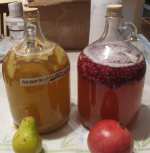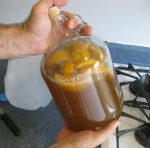My first and most important suggestion is to select the honey you are interested in. Find honey that is produced by specific varieties of flowers - it's called "Varietal Honey". The higher the quality of the honey, the better the mead! Contact apiaries and farmers market vendors.
Second, I find most people put too much fruit in their meads. Just an observation! A few lbs of well frozen fruit from Trader Joes is usually enough for a 5 gallon batch. Enough already! go for the honey-tastes! Also consider Irish Moss as an adjuct for fruit-wines.
Third - select your yeast from a home -brew shop or on-line category. Consider a lower-alcohol yeast, or your wine may come out too 'hot'. Consider blending different types of yeast. Also, consider carbonating your wine, particularly for dryer varieties! This can influence the sweet/dry part of the wine as much as how much honey you use!
Fourth, for those who like higher-alcohol brews, consider making 'jack' by freezing the wine and removing the first formed ice - this is called cold distillation. (Alcohol won't freeze.) Try a little at a time - I rarely do this though, the wine is just too good!
Answers to More Questions:
Other things I suggest are heat pasteurization when brewing - as little as possible, and matching acidity.
Pasturizing - heat up water to 170 or so, and pre-blend any fruit with a little water to pour into the hot honey-water at the last minute. Heat will drive off flavor, so it's important to not over-do it, i.e. heat the honey or fruit too long. Not sure if you're doing this already. When you heat the brew, but before you put in any fruit, the honey proteins float to the top - and can be skimmed off, making a clearer brew in the end. Obviously you don't heat all your water, and you can pre-chill the balance of the water and if you use glass as your primary fermenter, put this cold COLD water in the bottom of it to absorb the shock of the hot 'must' and protect the glass. Also, this cools the brew to yeast pitching temperature fast! I always suggest using the best quality water you can find (Poland Springs is excellent) but do not use distilled water.
One of the beauties of mead is that it comes out well, almost all the time. However if you want to make things more complicated, there are a few things that push it one way or another. Watching your acidity is one thing that you can do to alter your flavors. With fruits like raspberry, adjusting acidity is likely not necessary. But with straight honey, a little acid blend is yummy! Acid blend can be easily found, and I suggest a blend, not a single type (citric acid, maltic acid, etc). Little PH strips like you use for your pool can be found through a home-brew shop. Lemon would be a typical adjunct, if you feel funny using pure laboratory made citric acid.
Acidity generally balances alcohol 'heat' and sweetness. Time does wonders for mead's balance, too. Just make sure you have a dark place.
Some suggestions for bottleing - First, consider caps that absorb oxygen - they really do make a difference. Also, if you are willing to put a batch STRAIGHT AWAY into the fridge, I consider it safe to put a totally fermented still mead into mason jars. Some people tell me I'm crazy. You just don't want to carbonate or in any way risk further fermentation - cold temperatures and time ensure that. I usually only do this for brews that have been aging at least 3 months - the risk of an exploding bottle is too much for me or my carpets! Thankfully, this has never happened to me.
Lastly, keep brews out of the sun while they age, and HAVE FUN!
James

New, I and a friend made two wonderful meads today (melomels) a pear and a pomegranate. Just a few pictures and notes on what we did. Simply a lot of fun! See the pics here

New: The Ultimate Easy Guide to Successfully making one gallon of mead. - I have put together a video that shows you an almost fool proof method to make one gallon of mead
|
![]()



![]()


![]()